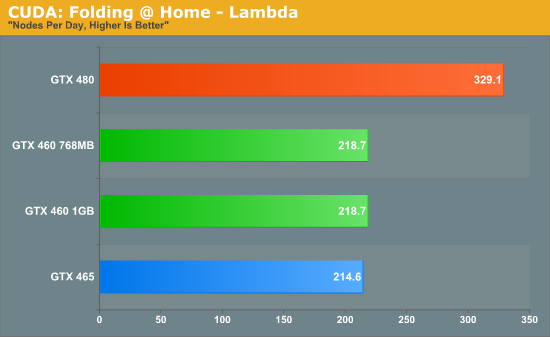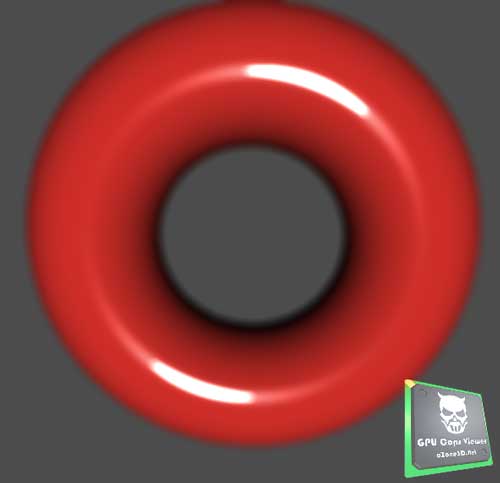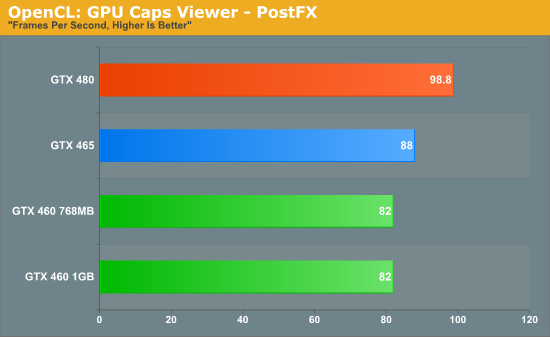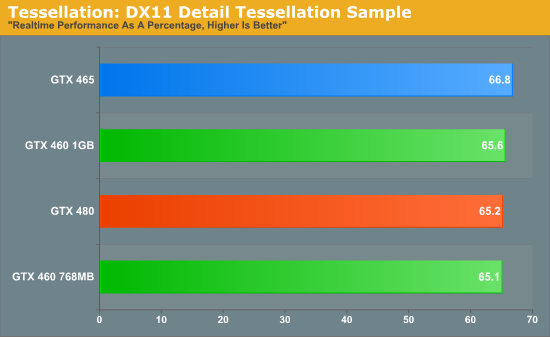NVIDIA’s GeForce GTX 460: The $200 King
by Ryan Smith on July 11, 2010 11:54 PM EST- Posted in
- GPUs
- GeForce GTX 400
- GeForce GTX 460
- NVIDIA
Compute & Tessellation Performance
With our earlier discussion on the GF104’s revised architecture in mind, along with our gaming benchmarks we have also run a selection of compute and tessellation benchmarks specifically to look at the architecture. Due to the fact that NVIDIA added an additional block of CUDA cores to an SM without adding another warp scheduler, the resulting superscalar design requires that the card extract ILP from the warps in order to simultaneously utilize all 3 blocks of CUDA cores.
As a result the range of best case to worst case scenarios is wider on GF104 than it is GF100: while GF100 could virtually always keep 2 warps going and reach peak utilization, GF104 can only reach peak utilization when at least 1 of the warps has an ILP-safe instruction waiting to go, otherwise the 3rd block of CUDA cores is effectively stalled and a GTX 460 performs more like a 224 CUDA core part. Conversely with a total of 4 dispatch units GF104 is capable of exceeding GF100’s efficiency by utilizing 4 of 7 execution blocks in an SM instead of 2 of 6.
Or in other words, GF104 has the possibility of being more or less efficient than GF100.
For our testing we’re utilizing a GTX 480, a GTX 465, and both versions of the GTX 460, the latter in particular to see if the lack of L2 cache or memory bandwidth will have a significant impact on compute performance. Something to keep in mind is that with its higher clockspeed, the GTX 460 has more compute performance on paper than the GTX 465 – 907GFLOPs for the GTX 460, versus 855GFLOPs for the GTX 465. As such the GTX 460 has the potential to win, but only when it can extract enough ILP to keep the 3rd block of CUDA cores working. Otherwise the worst case scenario – every math instruction is dependent – is 605GFLOPs for the GTX 460. Meanwhile the GTX 480 is capable of 1344GFLOPs, which means the GTX 465 and GTX 460 are 63% and 45%-67% as fast as it on paper respectively.

We’ll start with Stanford’s Folding@Home client. Here we’re using the same benchmark version of the client as from our GTX 480 article, running the Lambda work-unit. In this case we almost have a tie between the GTX 460 and the GTX 465, with the two differing by only a few nodes per day. The GTX 465 reaches 65% of the performance of the GTX 480 here, which is actually beyond the theoretical performance difference. In this case it’s likely that the GTX 480 may be held back elsewhere, allowing slower cards to shorten the gap by some degree.
With that in mind the GTX 460 cards achieve 66% of the performance of the GTX 480 here, giving them a slight edge over the GTX 465. Because we’ve seen the GTX 465 pull off better than perfect scaling here it’s very unlikely that the GTX 460 is actually achieving a perfect ILP scenario here, but clearly it must be close. Folding@Home is clearly not L2 cache or memory bandwidth dependent either, as the 768MB version of the GTX 460 does no worse than its 1GB counterpart.

Next up on our list of compute benchmarks is Badaboom, the CUDA-based video encoder. Here we’re measuring the average framerate for the encode of a 2 minute 1080i video cap. Right off the bat we’re seeing dramatically different results than we saw with Folding@Home, with the GTX 460 cards falling well behind the GTX 465. It’s immediately clear here that Badaboom is presenting a sub-optimal scenario for the GTX 460 where the GPU cannot effectively extract much ILP from the program’s warps. At 56% the speed of a GTX 480, this is worse off than what we saw with Folding@Home but is also right in the middle of our best/worst case scenarios – if anything Badaboom is probably very close to average.
Meanwhile this is another program with the lack of memory bandwidth and L2 cache is not affecting the 768MB card in the slightest, as it returns the same 35fps rate as the 1GB card.


Our third and final compute benchmark is the PostFX OpenCL benchmark from GPU Caps Viewer. The PostFX benchmark clearly isn’t solely compute limited on the GTX 400 series, giving us a fairly narrow range of results that are otherwise consistent with the Badaboom. At 82fps, this puts the GTX 460 below the GTX 465 by around 7%, once again showcasing that the superscalar GTX 460 has more trouble achieving its peak efficiency than the more straightforward GTX 465.


Our final benchmark is a quick look at tessellation. As GF104 packed more CUDA cores in to a SM, the GPU has more than half the compute capabilities of GF100 but only a straight 50% the geometry capabilities. Specifically, the GTX 460 has 45% of the geometry capabilities of the GTX 480 after taking in to account the number of active SMs and the clockspeed difference.
With the DirectX 11 Detail Tessellation sample program, we’re primarily looking at whether we can throw a high enough tessellation load at the GPU to overwhelm its tessellation abilities and bring it to its knees. In this case we cannot, as the GTX 460 scales from tessellation factor 7 to tessellation factor 11 by basically the same rate as the GTX 480 and GTX 465. This means that the GTX 460 still has plenty of tessellation power for even this demanding sample, but by the same measure it showcases than the GTX 480 is overbuilt if future games target GTX 460 for tessellation.
All things considered our compute and tessellation results are where we expected them to be. That is to say that the GTX 460’s wider range of best and worst case scenarios will show up in real-world programs, making its performance relative to a GTX 465 strongly application dependent. While the GF104 GPU’s architectural changes seem to be well tuned for gaming needs and leading to the GTX 460 meeting or beating the GTX 465, the same can’t be said for compute. At this point it would be a reasonable assumption that the GTX 465 is going to outperform the GTX 460 in most compute workloads, so the relevance of this for buyers is going to be how often they’re doing compute workloads and whether they can deal with the GTX 465’s lower power efficiency.










93 Comments
View All Comments
medi01 - Tuesday, July 13, 2010 - link
It was like that some day. But now I see more and more troubling signs. iPhone dissapearing from comparison photos ("oh, I've forgotten, it should have been in my pocket") when it has huge disadvantage, but always shown where it has advantage. (and happy readers crowd not "noticing" such "unimportant detail")AMD's 5830, the 200$ card with the same "it's slower than older... but it has some features" got serious beating right in the title. (guess what, it was actually cooler than older cards, so it had one advantage more than that of nVidia). On the other hand nVidia's 200$ card that is EXACTLY in the same positoin, got PRAISED in the title.
How on earth could that be called neutral?
ViRGE - Tuesday, July 13, 2010 - link
The 5830 launched at $240, not $200. In that respect the GTX 460 is not only launching at that cheaper price, but it's faster than the 5830 (and the 4890 the 5830 failed to beat).maxpain12 - Friday, September 17, 2010 - link
I agree with Lonyo, they are simply pointing out the technical aspects of the silicon. It gives those that follow the latest and greatest developments in chip architecture some food for thought. It was never intended to mislead a customer, the performance numbers are enough evidence to give the customer a decent understanding of what to expect in the real world application of the chip in consideration.Quidam67 - Saturday, July 17, 2010 - link
You're being a bit a of a fan-boy in my opinion. The article is very well balanced. Seriously, the 460 is the first good card from nVidia in a long time, and at a genuinely afordable price. ATI finally have some real competition on their hands. Up till now they have owned this generation. And the 5830 was always an odd fit for that market sector. Really, it was just an afterthought on how to repurpose 5870 rejects. It filled a hole, but now that hole doesn't exist anymore. It's the one ATI card from this generation that I really didn't like.Zendax - Saturday, July 31, 2010 - link
When the 5830 was released there was no current generation competition, so the only point of comparison was the past generation of cards.With the 465 the obvious points of comparison are the 5830 and 5850.
I'm not going to say, resolutely, that there's zero bias, but you're clearly LOOKING for an nVidia bias, and when you go about it that way, you're guaranteed to find it.
Goty - Monday, July 12, 2010 - link
... meh.It's a decent card, but it's still months too late.
notext - Monday, July 12, 2010 - link
I agree. It is good but AMD could easily drop the 5850 down to the 1gb prices and the advantage is gone. Hopefully they will.Quidam67 - Saturday, July 17, 2010 - link
That's what I hope will happen, because at the moment my next card is going to be a GTX 460 unless the 5850 price drops a littleDominionSeraph - Monday, July 12, 2010 - link
Not all of us scour rumor sites and wait with bated breath for months for the next big thing to come out. For some of us, waiting a few months is no big deal. (especially with the lack of any "must-have" gaming titles. The heyday of PC gaming is long over.)Since the launch-price 5850's (which didn't last long), the GTX 460 seems to be the first really good buy out there. The 5770 didn't outperform the 4870, the 5830 was an overpriced turd, the price-gouged 5850's and 5870's aren't good price/performance bargains, the GTX 470 and 480 are no better and are power hogs to boot.
THIS has me excited -- especially the SLI scaling. $400-$460 in cards that'll often beat a $700 5970? And they have low idle power consumption and decent load consumption (for the performance)? I mean in that price range is the 5870, GTX 480, and 4870 x2, and GTX 460 SLI beats them all. The 5870 has much lower load power consumption going for it but it's also significantly slower.
Unless you're going to need the power of 5870 in CF, the GTX 460 seems to be the way to go.
Rekdurexu - Monday, July 12, 2010 - link
"For everything but the high-end, this year is a feature yet and not a performance year."Is that "yet" supposed to be year?